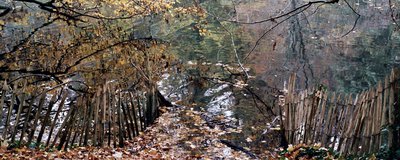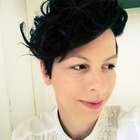Thinking-with the swamp

Abstract
The swamp doesn’t allow for a cartesian way of mapping, it doesn't allow to figurate it and give it a fixed identity. Connected bodies of water push their way into ever new sinks and streams. New spots of land are revealed, through drought or human intervention, while other parts flood and hide the pathways and places that were there before. Where the swamp starts and where it ends is processual. It doesn’t have clear borders but rather transient zones. As such, it is a liminal being, always becoming, always in-between.
Full text
The article is adapted from the presentation at The Swamp Gathering event in Brussels.
Thinking-with the swamp
The swamp doesn’t allow for a cartesian way of mapping, it doesn't allow to figurate it and give it a fixed identity. Connected bodies of water push their way into ever new sinks and streams. New spots of land are revealed, through drought or human intervention, while other parts flood and hide the pathways and places that were there before. Where the swamp starts and where it ends is processual. It doesn’t have clear borders but rather transient zones. As such, it is a liminal being, always becoming, always in-between. When interacting with and navigating a swamp one needs to adapt the human body to the liquid-solid body of the swamp. Moving in a swamp without careful consideration will end in getting stuck. The swamp invites us to find alternative temporalities and evaluate our ideas of progress. A stable ground founds our contemporary world and allows us to rush forward, giving resistance to push ourselves at speed through space/time. We have to re-think our operations when facing any swampy terrain, decelerate the human and call for attunement. The counterpart to attunement is imposition. The practice of draining swamps in order to make the land accessible for human projects. In line with a human-centered perspective that approaches other-than-human nature as a pool of resources, to extract and commodify.
~。.:*・If no mapping of the swamp is possible, then what to do with co-ordinates? Are they even necessary? 。~.:*・゜゚
Brussels was once a swamp. Many Belgian place names are connected to the swamp. Where the Flemish Moeras can be traced back to old French origins, Broek - is suggested to have Keltic origins, stemming from brâgo- 'region, land'. It is used for wetlands but also for forests. Place and language are intertwined and work, like peaty mud, as an apparatus that slows down time, that preserves a sliver from pasts no longer imaginable. Language, just like the swamps mud, forces us to live with ghosts and pasts un-dead, un-decayed. Something is rotting, but a form remains. Brussels, Bruxelles, Brussel, Broek Zele - a placename in a forgotten language seeps into mouths and minds that assemble here from many corners of the world. Swamps persist.
~。.:*・Feeling swamped, being bogged down, we're getting sucked in… being flooded, being mired 。.:*・゜゚
Our swamp conversations started when the three of us met at MASSIA , an artist residency in Estonia, and came to talk about bogs. MASSIA is located next to a big stretch of protected wetland which is classified as a bog. Like many areas in Estonia, the land near Massia is saturated with water. When you walk through the landscape you’ll see many human-made ditches, which help guide the water away from areas that are intended to be accessible for humans. When talking about bogs, swamps, and marshes we realised how unknown this category of land is to us –swamp tourists. Yet everybody had bits of information, connotations, imaginations and associations. A cumulative conversation unfolded, in which these reflections and knowledges layered onto a field of curiosities.
We found out that the Estonian word for swamp sounds the same as the word for gender, we found out that swampy words are connected to old languages, we found out that there are many types of wetlands, like bogs, swamps and marshes, each having distinct soil compositions, water systems and ecologies. We found many folk tales about swamps and who or what can hide in them. These wetlands turned out be generous material for thought, fertile ground for thinking along feminist, post- and decolonial, ecological, queer lines. The invitation for a swamp gathering in Brussels, building part of The New Local, was an opportunity to follow up on those informal conversations and continue the cumulative, speculative character of that initial exchange.
゜゚・*:.。~~~..。.:*・゜
:.~~ *・゜ ~~ *:.~~…
Mud, in Flemish modder, MODD DDER - sounds that suck us in. A mix of earth and water. An entity in-between solid and liquid, it only gives you an unstable grounding.
~。.*・But that is a good thing, no? We refuse to be “stable and strong.” We are stuck and vulnerable. When does that work with us and when against us? 。.*・゜゚~
Historically, the word "modder" was also used for rotting and in particular, the rotting of corpses. Marshes were drained to reveal the fertile soil and transformed into grasslands – profiting from the mud and rotting of past swamps. A lucrative activity for some. The creation of the stable grounds. The property grounds. The parsing through of mud. Parcelling out and handing over, again and again. A tiresome history. An ontology. Algorithms that count all and none.
~。.*・What is the time of mud? 。.:*・゜゚
Peat bogs are made up out of rotting plant deposits, mainly mosses, accumulating over hundreds of years. These muddy pools hide bog bodies – perfectly preserved human remains, sometimes thousands of years old. Bog bodies often keep their skin and internal organs due to the unusual conditions of the surrounding area, while their bones dissolve. The best preservation conditions can be found in colder climates, with proximity to salt water. The bog has a level of acidity that is very similar to vinegar, conserving the human bodies in the same way fruit or vegetables are preserved by pickling. The past gets locked in by the mud. The lack of oxygen slows down time even more, until fertile decay becomes impossible.
。.:*・How does a bubble travel in mud? Do bog bodies produce bubbles from the fermentation of the mud, skin and organs? 。.:*・゜゚
The release the bubble brings, pickled in a virtual pile of emails about swamps. Once a bog body is unmudded and exposed to the normal atmosphere, they may begin to decompose rapidly. As if, once freed from the time of mud, they try to catch up and disappear in the now. In mud baths, you can take joy in a different temporality. Think of the sluggishness and the swampiness, the drag time of the movement in mud. Could we think it? The sluggish intra-actions, like Barad helped us think them. Or is this only available through the physical experience of the mud-time, through the dragging of feet, the slipping of limbs too long to feel comfortable, too uncomfortable to feel like they are indeed our limbs, too tentacular to belong to the human.
。.:*・That should be a good thing, no? 。.:*・゜゚
If indeed a thing, it would probably surface from the mud – the swamp-being. We loved to think of it as a benevolent fungus, for example. What grows in mud and what do we take from it, what do we make of it? Mud pies. Mud kin. In mud, a string of water or watery substance creates a trail; it makes its way seemingly with ease through the consistency of the mud. The muddiness navigated more through time than through space.
。.:*・Is navigation an inherently human intention? What is it with this need to make our way through? - through things, people, routes, co-ordinates, relations with self and others, through classifications and species divisions? 。.:*・゜゚
Trying to navigate, but getting stuck, getting lost, slowing down. On the one hand a desired antidote for the always rushing obligation for progress and growth. But in Brussels, with it's sink holes of communes, institutions and ever-unfinished infrastructure, getting stuck also reminds us of the crisis of people forced to leave their homes behind and ending up in sticky paper swamps, continuously being detained from arriving. There are many ways to get stuck in these muddy times. A beauty treatment and a sinkhole are not the same.
゜゚
*・ (⌒▽⌒) :*
(⌒▽⌒) (⌒▽⌒)
Swamps are treacherous landscapes. There is always something hiding underneath. There are tales of thieves and witches. There are tales of monsters. But this constant uncertainty and transition also offers space for queerness. For beings that fall in between categories. Most carnivorous plants, for example, come from swampy ecosystems. The lack of nutrients in the soil makes them translate the qualities of the swamp into their insect-trapping forms. Sticky tentacles, smelly and seducing mouths, tubes to tumble down into and never resurface from. In our imaginaries they reside in between the vegetal and animal, just like the swamp is in between solid and liquid. The swamp as a site of ongoing becoming with no fixed identity. Carnivorous plants challenge our views of the vegetal other as passive beings that can do no harm. The swamp and its critters challenges our binary thinking. Thinking-with the swamp makes our categories muddy. Thinking-with the swamp means opening up to alchemic processes; bringing opposites together to mix, boil, simmer, ferment into new entities. Double beings, akin to the monsters, described by Anna Tsing as 'bodies tumbled into bodies'. They point us towards the entanglements of the swamp and our entanglement, both in matter and in imagination, with it in turn.
The swamp with it's mud, carnivorous plants, amphibians and un-dead fertility invites us to think AND/AND. To release the categories that were put upon the world. In the swamp worlds mingle. Ghosts and monsters find a home.
~~~彡°·_·°~°·_·°彡~~~
"It matters what stories we tell to tell other stories with; it matters what concepts we think to think other concepts with.” – Haraway, Staying with the Trouble.
~。.*・What matter are we mattering with? What material does thinking-with the swamp generate? Can we translate it into a fluid formula? Can we take it with us to other areas of thinking and doing? What if swamp-thinking would generate material for recipes? A recipe’s structural elements are ingredients and processes. A recipe is also a form of choreography, score, script, manual, guide which materialises in participation and leads one through an active experience. Adapted by its users according to their situatedness. Handed on. Ever transforming. Could a recipe breed a swamp-being – a spirit that can be released into our world? What could it shift in our thinking, perception and action?。.*・゜゚~
The swamp-being transitions between states; it constantly changes from one situation into another; organically and in intimate relation to its environment and other agents of its ecosystem. There is no linear progression from one state to another, there is no superiority of states, only constant flux. The swamp, like any other body, is the past, the present and the future. Layered. Meshed. Simultaneous. Nested. Situated. Localised. Embodied. The Swamp: between catastrophic time and time of re-seeding and germination.
・.
.・゜゚・
。.:*
┌( ~ ~ ~ )┐
 ̄ ̄ ̄ ̄
~。.*・Recipe for a potion ~。.*・ Make a liquid, whirl it into a foam, eat 3 spoons of it, add flour to it, knead a dough, bake a bread from it, eat 1 slice of the bread, soak the rest in water, then dehydrate it, break it into pieces and deep fry them, make a big bread salad (fattoush), don’t eat all the bread, take the soaked leftover pieces of bread and ferment them to a kvass, compost the culture, grow a squash, chop the squash, sprout some of the seeds, save some seeds to give to others to grow more squashes…..
~..~゜ ~~ *:.~~…~~~彡°·_·°~°·_·°彡~~~





